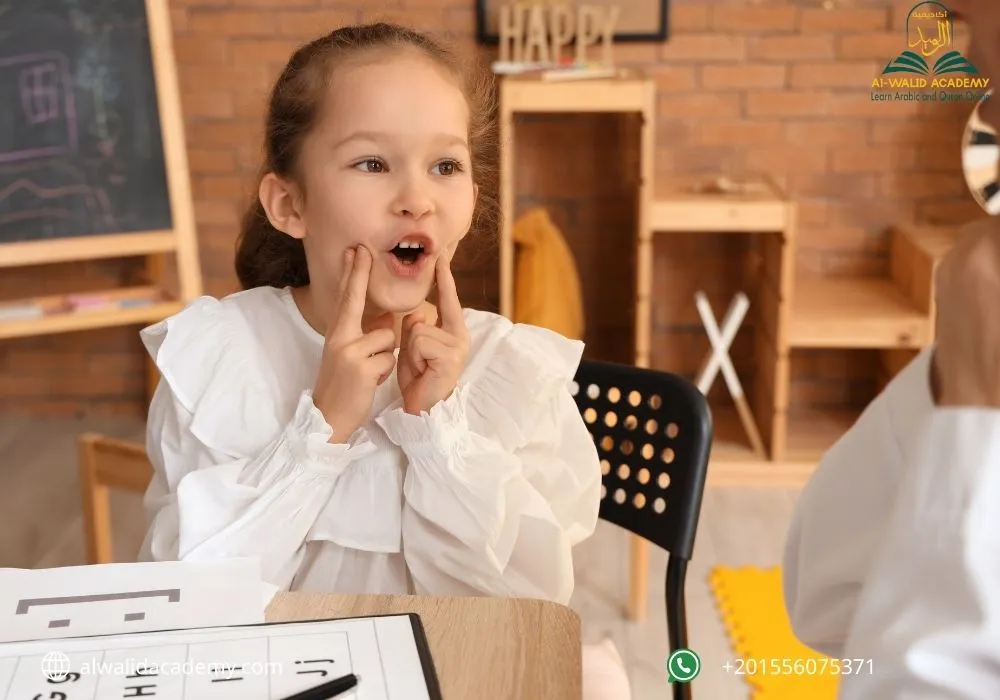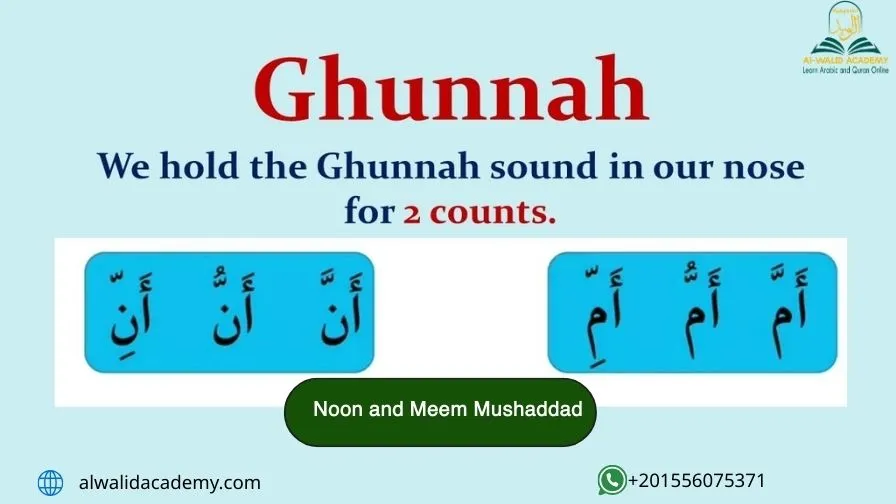Tajweed is the art that preserves the beauty, clarity, and meaning of the Quran. Among its foundational rules is the correct pronunciation of Noon and Meem Mushaddad, two consonants that require special care and attention due to the presence of shaddah and ghunnah.
In this article, we will explore what Noon and Meem Mushaddad are, the rules surrounding their recitation, common mistakes to avoid, and how learners whether beginners or advanced can refine their skills through listening, practice, and structured study. Al Walid Academy is here to guide you through each step with expert resources and support.
What is Noon and Meem Mushaddad?
In Tajweed, Noon Mushaddad (نّ) and Meem Mushaddad (مّ) are crucial rules that every student of the Quran should master. A Mushaddad letter is one that carries the shaddah ( ّ ) symbol, meaning it is doubled or emphasized in recitation.
When Noon or Meem comes with a shaddah, the reciter must apply Ghunnah, a nasal sound that lasts for two counts (two harakat).
Correctly pronouncing Noon and Meem Mushaddad ensures clarity, rhythm, and beauty in Quranic recitation while also preserving the authenticity of the divine message.
Definition and Importance in Tajweed
Definition:
Noon Mushaddad and Meem Mushaddad occur when Noon (ن) or Meem (م) appears with a shaddah, requiring the application of Ghunnah.
Importance in Tajweed:
-
It protects the recitation from distortion.
-
It maintains the traditional method of recitation passed down from the Prophet ﷺ.
-
It beautifies the Quranic sound, making it pleasant and spiritually moving.
-
It emphasizes the oral tradition of Tajweed, where sound and meaning go hand in hand.
This foundational rule acts as the gateway for students to progress toward mastering more advanced Tajweed applications.
Read about: Benefits of Becoming a Hafiz
Rules of Pronouncing Noon Mushaddad
The Noon Mushaddad (نّ) is one of the most emphasized rules in Tajweed because it requires clear articulation and proper application of the ghunnah (nasal sound). When a Noon is followed by a shaddah ( ّ ), it must be pronounced with a prolonged nasal sound that lasts exactly two counts, neither shorter nor longer.
This elongation is what distinguishes Noon Mushaddad from other pronunciations of Noon. Failure to apply the correct ghunnah results in a loss of clarity and alters the rhythm of Quranic recitation.
The Role of Ghunnah (Nasal Sound)
-
Ghunnah is the nasal resonance that must accompany Noon Mushaddad.
-
It should be sustained for two counts, creating a soft yet firm nasal sound.
-
This sound must flow naturally without being forced, ensuring balance between clarity and beauty.
Common Mistakes with Noon Mushaddad
-
Shortening the ghunnah: Cutting the nasal sound too quickly.
-
Overextending the ghunnah: Holding it for more than two counts.
-
Unclear articulation: Allowing the sound to merge with surrounding letters, losing distinctiveness.
Mastering Noon Mushaddad is essential, as it reflects precision, discipline, and respect for the divine words of the Quran.
Read about: Overcoming Challenges in Quran Memorization
Rules of Pronouncing Meem Mushaddad
When the letter Meem (م) is marked with a shaddah (ّ ), it forms Meem Mushaddadah, which, like Noon Mushaddadah is pronounced with a ghunnah lasting precisely two counts, adding clarity and rhythm to your recitation.
-
Always with Ghunnah: Meem Mushaddad must always be recited with a nasal sound.
-
Length of Ghunnah: The duration is two counts neither shorter nor longer.
-
Common contexts: Found in many surahs such as in عمّ or ثمّ.
-
Impact of mistake: Incorrect pronunciation reduces clarity and may distort the meaning.
The Role of Ghunnah in Meem Mushaddad
-
Ghunnah infuses Meem Mushaddadah with a smooth, echoing tone that enhances the fluidity and harmony of Quranic recitation.
-
It emphasizes the softness of the letter.
-
It beautifies the recitation and makes it easier for listeners to follow.
-
It adds to the rhythmic harmony of Tajweed.
Common Mistakes with Meem Mushaddad
-
Skipping Ghunnah: Reading the Meem sharply without nasalization.
-
Unequal timing: Making the ghunnah shorter or longer than two counts.
-
Ghunnah infuses Meem Mushaddadah with a smooth, echoing tone that enhances the fluidity and harmony of Quranic recitation.
Seems to be a long journey, don't hesitate to ask for our Tajweed Course.
Read about: Best Way to Memorise Quran
Duration of Ghunnah in Noon and Meem Mushaddad
The duration of Ghunnah in both Noon Mushaddad (نّ) and Meem Mushaddad (مّ) is an important element of proper Tajweed. Scholars agree that it must be held for two counts (حركتين) exactly no more, no less. Mastering this ensures balance in recitation and consistency across verses.
How Long Should the Nasal Sound Be Held
Two counts only: Ghunnah in Noon and Meem Mushaddad are always prolonged for two beats, similar to the rhythm of a short vowel.
-
Measured with breath: A student can practice by holding the nasal sound for the time it takes to say a short syllable twice, e.g., “aa-aa.”
-
Avoid extremes:
-
Too short: reduces clarity and loses the melodious effect.
-
Overextending the sound breaks the rhythm and burdens the recitation.
-
Consistency is key: The length should remain the same throughout all occurrences in the Quran.
This balance in duration not only preserves the beauty of Tajweed but also ensures adherence to the authentic way of Quranic recitation as taught by the Prophet Muhammad ﷺ.
Read about: How to Pronounce Arabic Letters with Tajweed ?
Examples of Noon and Meem Mushaddad from the Quran
Practicing with real Quranic verses is one of the most effective ways to strengthen your understanding and application of Noon and Meem Mushaddad rules. These examples make it easier to apply Tajweed practically.
Short Verses for Beginners
For students who are just starting, short and clear verses are ideal:
إِنَّا أَعْطَيْنَاكَ الْكَوْثَرَ﴾ (الكوثر: 1)﴿
-
Noon Mushaddad appears in "إِنَّا".
عَمَّ يَتَسَاءَلُونَ﴾ (النبأ: 1)﴿
-
Meem Mushaddad appears in "عَمَّ".
ثُمَّ إِلَيْنَا مَرْجِعُهُمْ﴾ (غافر: 77)﴿
-
Meem Mushaddad appears in "ثُمَّ".
These examples allow beginners to focus on mastering the correct Ghunnah (nasal sound) for two counts.
Longer Verses for Advanced Practice
For more experienced learners, longer verses provide better flow and challenge:
إِنَّ الَّذِينَ آمَنُوا وَعَمِلُوا الصَّالِحَاتِ لَهُمْ جَنَّاتٌ تَجْرِي مِن تَحْتِهَا الْأَنْهَارُ﴾ (البقرة: 25) ﴿
-
Contains Noon Mushaddad in "إِنَّ".
ثُمَّ إِنَّ رَبَّكَ لِلَّذِينَ عَمِلُوا السُّوءَ بِجَهَالَةٍ ثُمَّ تَابُوا مِن بَعْدِ ذَٰلِكَ وَأَصْلَحُوا إِنَّ رَبَّكَ مِن بَعْدِهَا لَغَفُورٌ رَّحِيمٌ﴾ (النحل: 119) ﴿
-
Contains multiple instances of Meem Mushaddad and Noon Mushaddad.
These advanced verses help learners maintain consistency in Ghunnah while handling longer recitations.
To master Meem Mushaddadah and other Tajweed rules, start by improving your Quran recitation with expert tips on voice control, rhythm, and consistent practice from trusted guides like Global Sadaqah and Hidayah Network. Learn more through our article How to Recite the Quran Beautifully ?
Importance of Ghunnah in Proper Recitation
The Ghunnah (nasal sound) is not just a technical rule in Tajweed; it carries deep spiritual and aesthetic significance in the recitation of the Quran. When practiced properly, the rules of Noon and Meem Mushaddad bring harmony and elegance to recitation, filling it with humility and a deeper connection to Allah’s words.
Spiritual Impact of Correct Pronunciation
-
Enhances Khushuʿ (focus in worship): The soft, prolonged nasal sound encourages reflection and emotional connection with the verses.
-
Strengthens sincerity in recitation: Applying Ghunnah with care shows respect for the Quran and obedience to the Prophet’s ﷺ instructions on Tajweed.
-
Deepens the listener’s impact: Those listening often feel more touched when the Ghunnah is clear and consistent.
Clarity and Beauty in Tajweed
-
Enhances fluency: Proper ghunnah ensures clarity and steadiness, avoiding rushed or muddled recitation.
-
Adds harmony to the rhythm: The balance of elongation gives the Quran its distinct melodic tone.
-
Ensures accurate transmission: Following Tajweed preserves the Quran exactly as revealed.
Mastering Ghunnah, therefore, is not optional; it is a vital aspect that combines spiritual depth with technical excellence in every recitation.
To truly master Meem Mushaddadah and other Tajweed rules, enrolling in a structured Quran Recitation Course like the one offered by Al Walid Academy.
Take alook to: Idgham With Ghunnah and Idgham Without Ghunnah

Practical Tips to Master Noon and Meem Mushaddad
Learning to apply the rules of Noon and Meem Mushaddad properly takes both knowledge and practice. Here are some effective strategies:
Listening to Expert Qaris
Follow authentic recitations: Choose well-known Qaris like Al-Husary, Al-Afasy, or Al-Minshawi who are famous for clear Tajweed.
-
Be mindful of ghunnah duration: it should extend the nasal sound precisely for two counts, adding clarity and rhythm to your recitation.
-
Repeat after them: Try to mimic their rhythm and pauses until your recitation feels natural.
-
Practicing with Repetition and Correction
-
Daily practice: Dedicate at least 10–15 minutes each day to reciting verses with Noon and Meem Mushaddad.
-
Record and review: Listening to your own recitation helps identify mistakes in Ghunnah or timing.
-
Seek feedback: A qualified Tajweed teacher can correct small errors that you might overlook.
Practicing with Repetition and Correction
-
Daily routine: Dedicate 10–15 minutes each day to verses containing Noon and Meem Mushaddad.
-
Record yourself: Listening back helps you catch errors in Ghunnah or timing.
-
Seek correction: A qualified Tajweed teacher or mentor can guide you to avoid repeated mistakes.
Additional Helpful Methods
-
Use color-coded Mushaf: Some Qurans highlight Tajweed rules visually, making it easier to spot where Ghunnah is required.
-
Break verses into parts: Focus on one Mushaddad at a time before combining them in longer recitations.
-
Stay consistent: Mastery comes from gradual, steady effort rather than rushing.
By combining listening, repetition, and guidance, you can achieve fluency in applying these Tajweed rules and bring both beauty and accuracy to your recitation.
Read about: How to Learn Quran with Tajweed at Home
Learning Noon and Meem Mushaddad with Al Walid Academy
At Al Walid Academy, the journey of mastering Tajweed, including the rules of Noon and Meem Mushaddad, is made simple, structured, and highly effective. The academy focuses on providing students with personalized guidance, ensuring that every learner from beginners to advanced reciters understands not just the theoretical rules but also their correct application in recitation.
What Makes Al Walid Academy Special?
-
Expert Teachers: Qualified instructors who specialize in Tajweed and Quranic sciences.
-
Interactive Learning: Live sessions with feedback to correct pronunciation mistakes instantly.
-
Step-by-Step Progress: Lessons that gradually cover the rules of Ghunnah, duration, and clarity in recitation.
-
Practical Exercises: Daily recitation practice, with emphasis on avoiding common errors in Noon and Meem Mushaddad.
-
Spiritual Growth: Students are encouraged to connect deeply with the Quran, experiencing both clarity in recitation and the beauty of its meanings.
By enrolling in Al Walid Academy’s Tajweed programs, students gain confidence, discipline, and fluency in applying Noon and Meem Mushaddad rules. This structured support helps learners preserve the authenticity of Quranic recitation while strengthening their spiritual connection with the words of Allah.
Learn Quran, Arabic, and Islamic Studies with certified teachers in fun, interactive, and personalized sessions. Join thousands of students around the world and begin your path today!
Conclusion
Learning the proper use of Noon and Meem Mushaddad is a cornerstone in Tajweed, ensuring clarity, precision, and authentic recitation of the Quran. By understanding the role of Ghunnah, practicing correct duration, and avoiding common mistakes, learners not only enhance their pronunciation but also experience the spiritual depth and beauty of the Quran. Consistency, listening to expert Qaris, and practicing with guidance are the keys to success.
At Al Walid Academy, we provide structured courses that help students perfect their Tajweed skills with personalized support and expert teachers.
Whether you are a beginner or an advanced learner, our programs ensure that you gain confidence in reciting the Quran with clarity and devotion. By committing to learning these rules properly, you are taking a valuable step toward preserving the authenticity of Quranic recitation and strengthening your connection with the words of Allah.
FAQ
1. What is the meaning of Noon Mushaddad and Meem Mushaddad?
Noon Mushaddadah and Meem Mushaddadah are the letters Noon (ن) and Meem (م) marked with a shaddah (ّ ), signaling emphasis and requiring a nasal sound ghunnah for smooth and proper Quranic recitation.
2. Why is Ghunnah important in Tajweed?
Ghunnah ensures the correct pronunciation and elongation of nasal sounds, enhancing the clarity, beauty, and spiritual impact of Quranic recitation.
3. How long should I hold the Ghunnah?
Typically, the Ghunnah is held for two counts (2 harakahs), though some verses may require a slightly longer duration based on the rules of Tajweed.
4. Can beginners practice Noon and Meem Mushaddad?
Yes, beginners can start with short verses and gradually progress to longer verses, focusing on proper pronunciation and consistent repetition.
5. What are the common mistakes to avoid?
Omitting or shortening the Ghunnah, mispronouncing the letters and Reciting too quickly without clarity.
6. How can I improve my recitation?
Listen to expert Qaris for correct pronunciation and Practice daily with repetition and correction
Seek guidance from a structured course such as the Tajweed program at Al Walid Academy.
7. Can Noon and Meem Mushaddad rules be applied in English learning?
While Tajweed rules apply to Arabic recitation, understanding them conceptually in English translations helps learners connect meanings with proper recitation.

